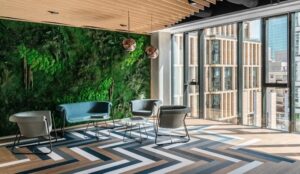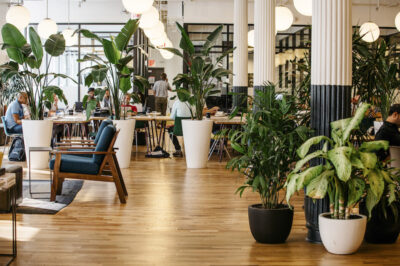Encouraging people to return to work. Biophilic office design.
After long periods of working from home, how can we use Biophilic Office Design to make it more attractive for employees to return to physical offices?
As employees have adjusted to working from home traditional office spaces now have a lot to compete with. According to Australian data, the most popular reason for preferring working from home is not having to endure the commute to work every day. A close second is the flexibility of working from home, as well as saving money. Other benefits include the increased work-life balance and more time with family, even when the overall hours can often be longer working from home.
Personally, as someone who provides online training for teams working from home, I would add that there are a dozen little conveniences that don’t feature in formal surveys. Off the record people will admit to preferring their more comfortable clothes, being able to put on a load of washing between meetings or preparing meals in one’s own kitchen.
Managers need to be a little careful here. With so many people now accustomed to working from home, there are increasing reports of people preferring to quit their jobs when bluntly ordered back to the office.
So how can traditional workplaces compete with the comfort and convenience of people’s home environments?
Perhaps the most overlooked factor in making physical work environments attractive is Biophilic office design. This term was coined in the 1980s when the biologist Edward Wilson theorised that our modern trend towards urbanisation was causing an unhealthy disconnection from the natural world.
Architects who recognised this embraced Biophilic office design. They began designing office environments that were more natural and agreeable by creating spaces that were more open, featured larger windows, and utilising more organic materials that resembled natural landscapes.
Importantly, bringing a little nature into the workplace is more than a design trend. Studies show Biophilic principles are good for staff engagement. For example, Biophilic design increases creativity and focus, and faster problem solving. It also significantly lowers stress levels.

Staff engagement and stress management
But beyond the efforts of architects and interior designers, how can ordinary managers harness these benefits in the workplace?
It turns out there are several things managers can do with their existing premises. In one study when people spent 90 minutes away from the office and walking through grasslands, they reported more positive emotions and lower stress compared with people who walked through busy city streets. Brain scans also confirmed this group showed less stress and less cognitive rumination activity.
If that seems too much to arrange, more recent studies have found we don’t necessarily need long walks. Researchers in the UK have found similar benefits whenever our total ‘nature time’ approaches two hours per week in total. In fact, beyond two hours the benefits begin to diminish suggesting two hours with nature is a kind of goldilocks zone. This can comprise regular short walks during work breaks, supplemented by one’s own weekend time spent exercising, gardening, or even walking the dog.
Japanese researchers have found similar benefits with time spent in “Shinrin- Yoku” (forest bathing). It seems passive, gentle connection with nature is what matters, with or without the exercise component. This finding is supported by other studies showing stress-lowering benefits when people simply looked at nature images, plants, or even listened to birds singing.
Managers should take particular note of these last findings. While not all workplaces are conveniently located nearby a beautiful park or grasslands, managers still have a degree of control over the indoor atmosphere of workplaces including décor, paintings, indoor plants, and screensaver images. The bottom line is connecting with nature makes us happier, more engaged and healthier making managers well advised to create workspaces that support these kinds of connections.

Here are some practical suggestions to incorporate Biophilic office design, ranging from the simple to the more elaborate.
- Bring more plants into the office space.
- Artwork and prints. Nature-based artwork adds to the ‘nature theme’ in your office.
- Incentives. Give new plants to your staff as part of how you recognise performance. Make ’employee of the month’ more about nature.
- Office furniture. Reduce plastic and bring natural materials such as wood into your workspaces.
- Fake plants? Modern imitation plants can be hard to distinguish from the real thing, and still bring an element of wellbeing to the office.
- Make better use of unused outdoor spaces by positioning outdoor furniture.
- Vertical garden. If your budget allows, incorporate a living wall or vertical garden.
- Water. Notice how dentists’ waiting rooms or similar waiting spaces use water features or fish tanks to promote calm.
- Focal Walls. These are large displays or murals depicting nature which can evoke feelings of being outdoors.
What is your experience? Please leave us a comment below.
References and further reading
Bratman, Gregory & Hamilton, J. & Hahn, Kevin & Daily, Gretchen & Gross, James. (2015). Nature experience reduces rumination and subgenual prefrontal cortex activation. Proceedings of the National Academy of Sciences.
Brown, D.K., Barton, J., & Gladwell.V. (2013). Viewing Nature Scenes Positively Affects Recovery of Autonomic Function Following Acute-Mental Stress. Environmental Science & Technology 47 (11), 5562-5569.
Ulrich, R. et.al. (1991). Stress Recovery During Exposure to Natural and Urban Environments. Journal of Environmental Psychology. 11: 201-230. Journal of Environmental Psychology. 11. 201-230.
White, M.P. et al. (2019). Spending at least 120 minutes a week in nature is associated with good health and wellbeing. Sci Rep 9, 7730.
Giancarlo M, et.al. (2017). Bringing nature to work: Preferences and perceptions of constructed indoor and natural outdoor workspaces. Urban Forestry & Urban Greening, Volume 23, P 1-12

